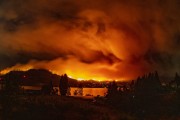Since we recently passed a pop culture milestone, let’s hop in the DeLorean and travel back in time: the year is 2011, and Alberta has just commissioned its most advanced coal power plant, near Wabamun Lake west of Edmonton.
Equipped with a supercritical boiler, Keephills 3 is expected to produce 60 to 80 per cent less air pollution per unit of power than the older coal-fired units that have recently been decommissioned in the area. In particular, emissions of sulphur dioxide (SO2), nitrogen oxides (NOx) and mercury will be reduced.
That’s significant, because SO2 and NOx pose serious health risks to Albertans and place a burden on our health care system. Both of these pollutants also contribute to the formation of secondary fine particulate matter, which has been linked to extreme wintertime smog in Edmonton and to elevated ambient pollution across the province.
Now, let’s go back to the future: an Alberta where air pollution from coal power is falling. Except that’s not what happened. Reported air pollution from coal plants in the Edmonton region — including Keephills, Sundance, Genesee and Wabamun before its closure — did fall from 2010 through 2012. But when we look at the latest data from 2014, both SO2 and NOx emissions have climbed back to some of the highest levels seen since 2006.

So what happened? Emissions from coal-fired power fell in 2011 and 2012 when the two Sundance coal units were taken offline due to a breakdown. But when those units returned to service in 2013, coal generation — and the associated emissions — ticked back up.
The drop in emissions during the Sundance shutdown shows the tangible and immediate air quality benefits of reducing coal-fired generation. But to reap those benefits, we to need invest in more clean generation that can take the place of coal.

Fortunately, Alberta has an abundance of alternatives to coal that produce much less air pollution. An accelerated phase-out of coal power provides multiple benefits to the province. Not only will there be substantial carbon emissions reductions, which can be part of the province’s new climate change strategy, but the air will be cleaner in downwind communities like Edmonton and Red Deer. That’s a future Albertans can look forward to.









